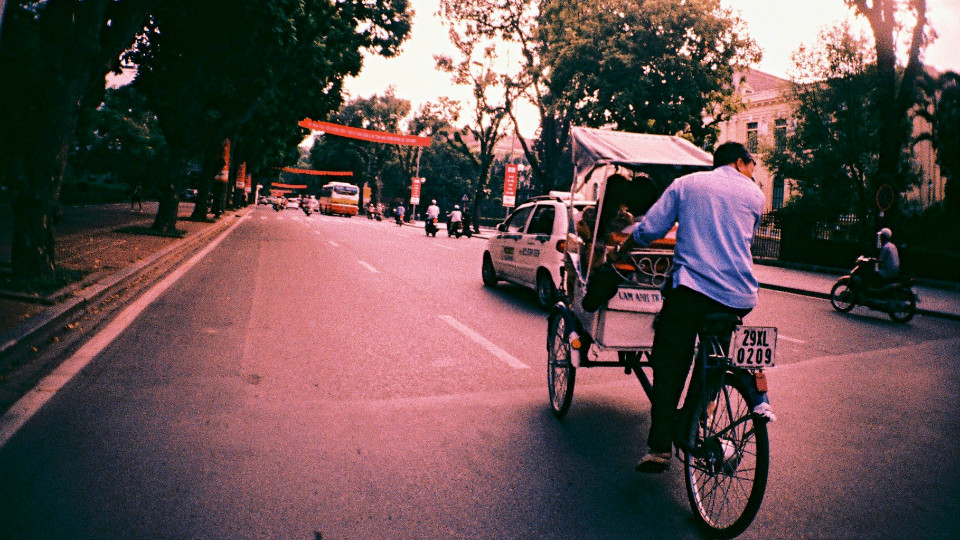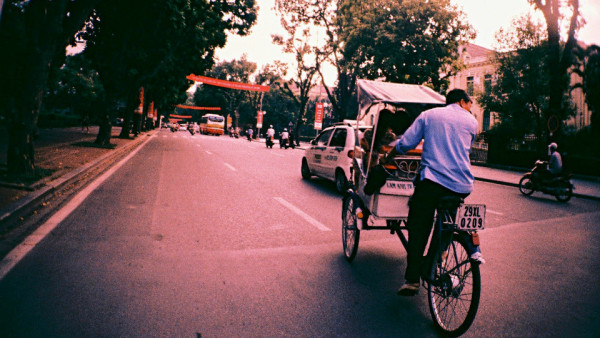
There’s something to be said about visiting the country where your parents were born and raised for the first time. And sometimes there’s that glimpse of understanding into who they are.
I got a small taste of this when I moved to China for the first time. I was trying to get my resume printed so I found a local Chinese print shop and after three hours of trying to communicate, I left in tears, with everything printed on even shittier Chinese-quality paper—yes, there is such a thing—unquestionably sure I had been overcharged. No one talks about that part of moving abroad.
I then called my mother, who never completely understood why I had moved to a Communist country after my parents deliberately fled the Communists in 1974. I bawled, and after some silence, she had one thing to say to me: I told you it’s not easy moving to another country. And suddenly something clicked inside.
Both of my parents were born in Ho Chi Minh City, or what used to be known as Saigon, though my mother’s family originally hailed from the more French-influenced and reserved Hanoi up north. She came from an upper middle-class family with a penchant for buttery croissants and strong ties to the government. Rolling, green mountains of Sapa and the limestone karsts of Hạ Long Bay and Ninh Binh dot this part of the country and good, good baguettes is something my mother is still obsessed with.
It's worth noting that for almost 70 years before the war, Vietnam had been an integral part of French Indochina. French culture seeped into the country like a stew simmering on the stove for hours — it’s even nearly impossible to talk about Vietnamese cooking without acknowledging its French confluence these days.

American troops in Vietnam. (The U.S. Army / Flickr)
Meanwhile, my father’s family hailed from Dong Ha, a small, simple town just outside of Hue in central Vietnam. Today both cities are more often a stopping point for veterans that fought in the Vietnam War though it does hosts some beautiful, less-tracked and just-deserved tourist paths. As the war raged on between the North and South, between communism and democracy, this particular region became important: it demarcated the border of the Vietnamese demilitarized zone.
Though my parents actually didn’t meet until many years in Washington, D.C., both families coalesced in Saigon for a brief time. In true form, everything converges in the South: it’s a vibrant, pulsating and interlocking mix for different walks of life. The jungle and beaches take over in this part of the country, and Saigon is both things in one. It pushes and expects pushes all in jostling, jockeying fun and seriousness.
In Vietnam, expect to be pushed, stretched and somewhere in the middle of that, expect some unexpected raucous cheers and camaraderie in the unlikeliest of places — because amidst all the conflict, you just have to.
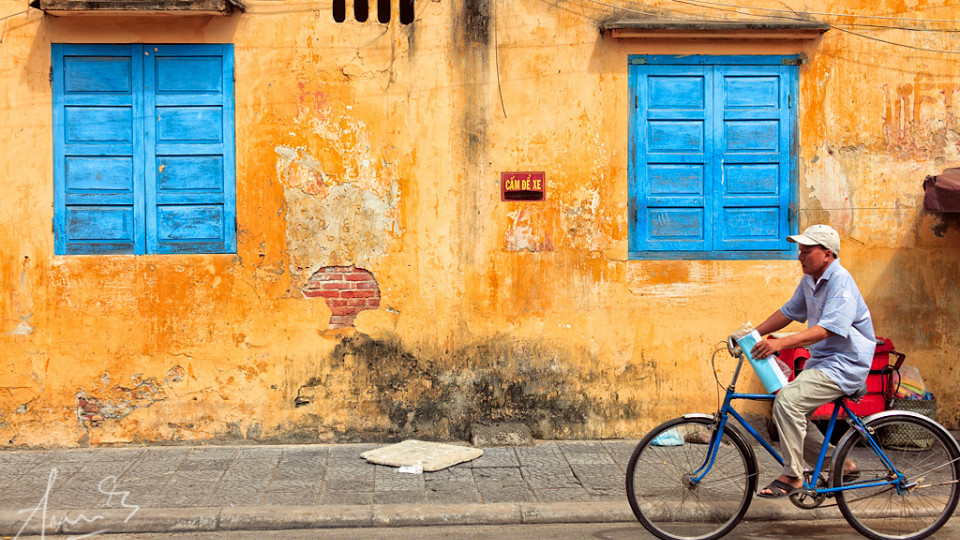
Biking in Hanoi. (Sacha Fernandez / Flickr)
The Cheatsheet
| Language | Vietnamese |
| Currency | Vietnamese đồng (VND, ₫) |
| Entrypoint | Tân Sơn Nhất International Airport (SGN) |
| Visa | Single- or multiple-entry for one or three months. Cost varies. |
| Departure Tax | Included in airfare ticket. |
| Water Drinkable? | No |
| Tipping | 2,000-4,000 VND in restaurants, more for higher-end establishments |
| VAT Refundable | 85% of VAT on eligible goods. Must be bought from a single shop in a one day duration and must value VND2,000,000 (~$91.72 USD). |
| Power Socket | European pin |
| Country Code | +84 |
| Everyone Drives on the... | Right (or ambiguous!) |
Language
People speak Vietnamese. No, not everyone speaks Chinese in Asia. For the most part, though, most tourist areas and operators speak English. Don’t forget: the influence of American troops in Vietnam during the Vietnam War was a powerful event that embedded itself into the memory of the country.
Though the French used to have a linguistic legacy in colonial Vietnam when the country was part of Indochina, there’s not many speakers left in the country. It might be possible to get by if you run across someone from the elderly and educated populations but don’t bet the farm on it. In fact, it's literally a "young" country; the median age is 29.
Cities and Airports
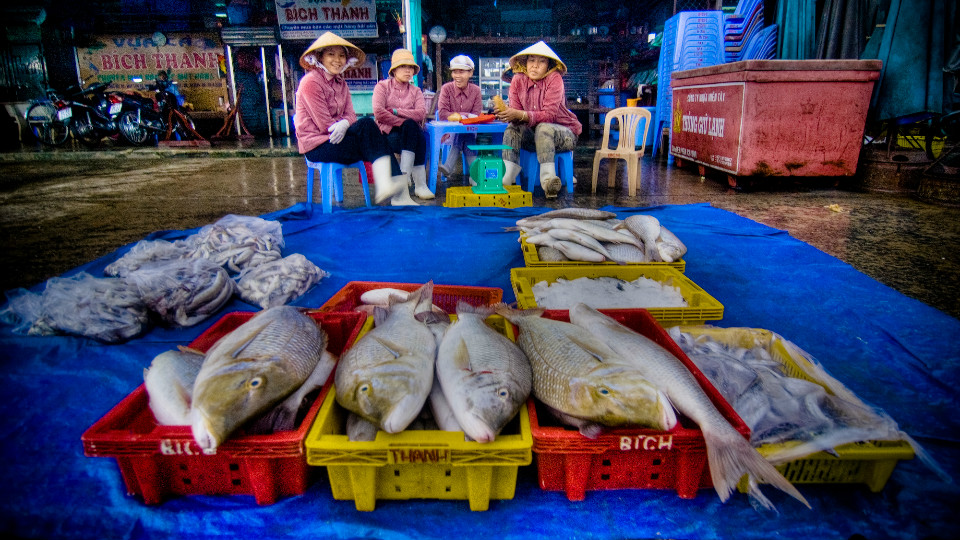
At the market. (Lucas Jans / Flickr)
The main airport and entrypoint for the country is Tan Son Nhat International Airport (SGN) in Ho Chi Minh City in southern Vietnam. Please note that even though the official name of the city is Ho Chi Minh, many domestic and expat Vietnamese still often refer to it as Saigon. From the main city, it’s only about 4 miles (7 km) in the city so it’s a super, super quick ride into the heart of the city. Like 15 minutes.
The second-most common airport for travelers to enter the country through is Noi Bai International Airport (HAN) in the north and serves Hanoi. However, most of the airlines that enter through this are those coming from more regional routes and other parts of Asia. Long-haul passengers are more likely to pass through Tân Sơn Nhất first before transferring to a domestic route through Hanoi.
Visa
To enter, a visa is required for Americans. The cost of visa depends on whether it’s a single-entry or multiple-entry visa and the length of the visa. For the most part, Americans are allowed to apply for a visa that lasts up to three months maximum.
Unfortunately, like with a lot of other Asian countries, the cost of the visa will really depend on where you get it — each embassy sets its own price. For those who apply through the Washington D.C. embassy, the cost begins at $100. I seem to remember paying about $500 HKD ($64.49 USD) through the Hong Kong embassy. But, actually, if you want to save on visa fees, it’s highly recommended to get visa on arrival.
Confession: I’m a visa do-gooder. I will sit patiently at the actual embassy weeks in advance to get a visa but it is not the cheapest or efficient way to obtain a visa for Vietnam. And then come back five days later to pick it up.
It wasn’t until I lost my passport before one of my Vietnam trips that I was forced to do visa on arrival. There are many small Vietnamese agencies that will, for a small fee ($10-$20), issue a letter of approval for. This later needs to get stamped for another fee ($45-95) paid at the airport. The stamping fee is only payable in U.S. cash; just be aware visa on arrival is only available at Tân Sơn Nhất International Airport (SGN), Nội Bài International Airport (HAN) and Đà Nẵng International Airport (DAD). It is not available for land crossings or any other airport.
In the end, it cost me $55 USD total through Vietnam Visa Pro—far lower than any embassy cost I’ve seen—in as little 1-2 days. It can seem a little shady from a Western perspective but there have been many people that have done it that way with no issue. I’ll never do it via embassy again.
On a side not, those that can prove Vietnamese descent are eligible to apply for a five-year visa for a similar cost as one multiple-entry visa. For those who return to Vietnam often, it’s a good investment but requires considerably much more hassle.
Transport
Where to start? Maybe with motorcycles that rue the land? They're often the most efficient method of getting around... and if you're a lone traveler, it's possible to haggle with a cyclo to get discounted rates and get somewhere for a simple $1-5 USD depending on distance. They're just an extremely efficient and cheap way of getting around.
But it begs the question of crossing the street safely. In Saigon, there's only one way to do it: without hesitation. The most important thing is to walk in even, steady pacing with zero unpredictability across the street. Most drivers have developed the uncanny knack for driving around and avoiding pedestrians but you can't wait for them because they'll never wait for you. If in doubt, wait for a local to cross and use them to shield oncoming traffic. They know what they're doing.
Then there's taxis. There are plenty of imitation and shady taxis around. The two biggest—and most reputable—taxi companies are Mai Linh and Vinasun. Even then, there are fake Mai Linh and Vinasun taxis. Be sure to get a hotel operator or taxi operator to call one; if in doubt, check the taxi driver is wearing a uniform and tie and that the phone number on the taxi is consistent. Fake taxis will more than take you for a ride; they will jack up the meter so it runs at ridiculous rates.
In particular, in less developed countries, I sometimes like to walk out of the international terminal and down to the domestic terminal where I'll pick up the cab. (Locals tend to know the scams so the scammy ones are less likely to hang around there.)
For long-distance travel, a wide variety of options include chartered car, day and sleeper trains as well as sleeper overnight buses. Just know domestic flights are prone to flight delays, if the airport is even operating at all. The main domestic airlines within Vietnam include Jetstar and Vietnam Airlines. Aside from those, overall, Vietnamese budget airlines have a habit of opening and shutting down within a few years.
Compared to Western infrastructure, Vietnamese is much less developed so don't be surprised if distances that normally would take a day or less take a day or two to travel between, especially between small cities. It is still, however, much more developed than places like Burma and so forth.
Money*
| USD $1 = 21,805 VND (~20,000 VND) |
| USD $5 = 109,025 VND (~110,000 VND) |
| USD $10 = 218,050 VND (~220,000 VND) |
*accurate at time of publication
The official currency is the Vietnamese dong (the U.S. dollar is referred to as dô). This is the main currency for transactions though đô is always happily accepted—especially in tourist areas—because of its worth relative to the đồng. It’s still cheaper to pay in đồng.
Food and Drink
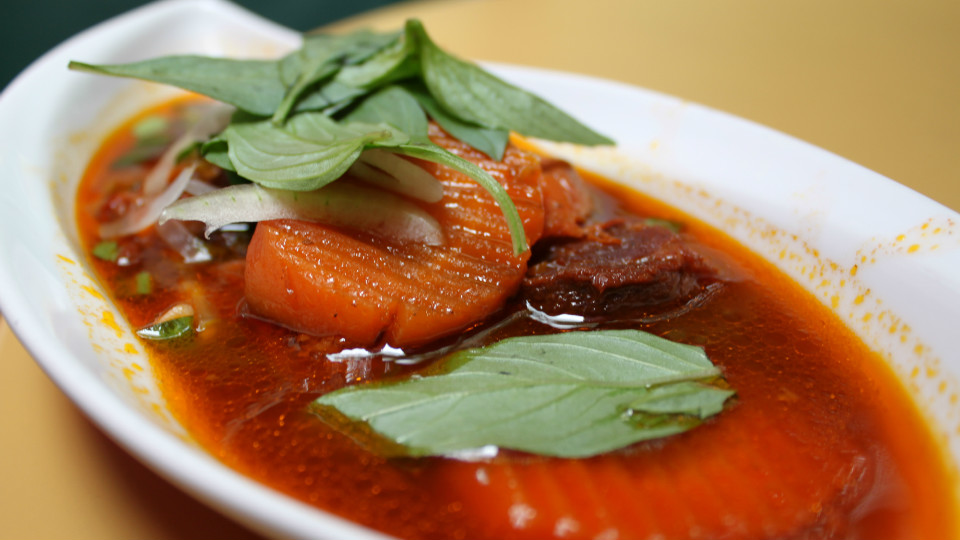
Bo kho, a slow-cooked beef and carrot curry with a french baguette. (Erica Ho / Map Happy)
There is more to life than phở. Or banh mi. But getting straight to the point: Most Vietnamese dishes consist of several elements like fish sauce, noodles, shrimp, pork, lettuce, beef, bean sprouts, veggies, lemongrass, cilantro and rice and in varying combinations. This is Southeast Asia at play here, with a variety of sweet, salty, spicy and boldness laced into everything.
Most tourists will find that the South is the most identifiable in terms of Vietnamese fare represented overseas. The national staple is phở, a delicate beef soup stewed with noodle. Banh mi (which directly translates to “sandwich”) is the American equivalent of a peanut and butter jelly sandwich, served on a French baguette (basically what my mother fed me to shut me up). The French indelibly left their mark on the country through its food and it can be seen through Vietnam’s obsession with baguettes, coffee and pastries.
In fact, drinking coffee, cà phê sữa, is practically its own national pastime here and is served with strong bitter overtones dunked with condensed milk. Though it can be taken hot, most people choose to take it with ice (cà phê sữa đá) because of the country’s hot, humid weather. In the end, it all sorta makes sense because Vietnam is the second-largest exporter of coffee in the world.
The Hue region is known for its particular specialties such as bún bò huế, bánh bột lọc and other regional dishes. (I often like to describe bún bò huế as phở’s flaming, flamboyantly spicy and gay cousin. Phở is more delicate, bún bò huế is more in your face, like ramen.) Vegetarians will also glee when it comes to Hue: it’s one of the few parts of the region that have an emphasis on chay food, which centers around what else? vegetarian dishes.
Unsurprisingly, Northern food is different from Southern food. Representative of its cities’ personalities, Southern food is more vibrant and bold where Northern food is more subdued (and arguably more “refined”) due to a larger French influence.
Do take the time to enjoy Northern food because stylistically, it’s one of the few places left in the world where it can be found. When most nationals fled the country following the Vietnam War, they emigrated from the South and left most of the unique flavor preferences of the North behind. Northern specialties include dishes such as bún chả and bánh cuốn.
For the uninitiated, Wikipedia has a handy cheat sheet to Vietnamese cuisine.
Timelines
Do people just eat all the time or is that just me? I think it's just me. Meals are taken rather ambiguously in line with the U.S. schedule. For the most part, it's always possible to find something to eat at most hours of the day... street food is abundant. And arguably better than anything you can find in a restaurant.
In terms of differences, it tends to be mostly a city/country thing. Small cities are just likely to get quieter much quicker. In the city, things are always bustling in the right part of town. People tend to go out late at night, around 11 p.m.
Water

Phu Quoc islands down south. (Nathalie Capitan / Flickr)
It is not safe to drink the water in Vietnam. Bottled water is strongly encouraged.
Communication
There are many, many network operators that operate within Vietnam. Though I am most familiar with Viettel, it might be worth getting suggestions from hotel staff. In general, though, any of them should be work. Prepaid sims start at 75,000-100,000 VND ($3.44-$4.60 USD) for calls, texts and 3G data for pennies on the dollar.
Safety
Unlike China and the rest of Asia, crime in Southeast Asia is much more prevalent. Fortunately, compared to the rest of the world, when it does happens tends to be more petty theft than violence. This includes Vietnam.
It's important not to develop 'tourist blindness,' which people tend to develop on vacation because they're so intent on having a good time. Destinations like Southeast Asia are cheap but that's because the cost of living is low and residents make far, far less than Westerners. The local monthly salary can amount to about $100-200 USD per month. Most residents are aware of the vast income disparities and will take advantage of this when they can.
This means taking care to only pull out your huge DSLR to take a photo when you need it and not needlessly carrying it around like a stupid tourist. Though many vacationers seem completely oblivious, many different tourist vendors would secretly confide to me all the crime they recently witnessed to me and warn me to be extra careful in Vietnamese — a conversation that I observed didn't seem to be happening in English.
In addition to taxi scams and pickpocketing, motorbike snatching can happen in larger cities. They have been known to snatch bags, mobile phones, cameras and jewelry off pedestrians—tourist and local alike—as they walk by. If you do, make sure to carry your bag on the side away from the street. Also, don't resist if the bag is snatched because otherwise you’ll risk being inadvertently pulled into oncoming traffic.
There is also a common scam among lower-end and mid-range scams hotels where rooms are broken into and belongings are stolen during the middle of the night. This actually happened to me and my family while we were sleeping; so while it's easy to discount reviews like that, they do happen and read up. I got into the habit of carrying and using a cheap door magnetic alarm from the dollar store to err on the safe side.
To drill it down: It's better not to flaunt your wealth. You wouldn't do it in East L.A., so why would you do it here?
Power
European-style plug — the French did get here first.
Additional Links
U.S. Consulate General in Ho Chi Minh City
4 Le Duan Blvd., District 1
Ho Chi Minh City Vietnam
Tel: + 84-8-3520-4200
Fax: +84-8-3520-4244

The highlands. (Nhi Dang / Flickr)


